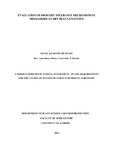Evaluation of drought tolerance mechanisms in Mesoamerican dry bean genotypes
Abstract
Drought is a major abiotic constraint to common bean (Phaseolus vulgaris L.) production globally. It results into yield losses of over 60% depending on severity, time and duration of occurrence. In the face of climate change and variability, droughts have become frequent and more severe in Kenya leading to reduced bean production. It is therefore important to curb further decline in dry bean production and enhance food security by developing drought tolerant varieties of dry bean. Of the two major dry bean gene pools, the small seeded Mesoamerican beans are considered to be more drought tolerant than the large seeded Andean beans. However, little has been done to develop drought tolerant bean varieties and to understand the mechanisms of drought tolerance in Kenya and East Africa in general. The objective of this study was to identify physiological and phenological traits associated with enhanced drought tolerance in Mesoamerican dry bean genotypes. Eighty-five small and medium seeded bean lines were evaluated for drought tolerance on-farm in Mwea in Kirinyaga County and on-station at Kabete Field Station of the University of Nairobi between April 2011 and March 2012. Participatory varietal selection was conducted in Mwea and Kabete Field Station to identify the most drought tolerant lines based on farmers‟ selection criteria. Selectors were well qualified dry bean farmers, traders and consumers. The on- station field trial at Kabete Field Station was used to study physiological mechanisms of adaptation to drought stress including stomatal control and assimilate partitioning. Both trials were conducted during the dry periods of the year to avoid unexpected moisture supply. The
85 Mesoamerican dry bean genotypes which included three market classes (navy beans, small reds and mixed colours), local and international checks with contrasting drought responses were tested under drought stress and non drought stress conditions. Irrigation was withheld at pre-flowering to induce moisture stress. Non destructive sampling of plants for canopy temperature, leaf chlorophyll and stomatal conductance measurements was conducted at flowering and mid-pod filling stages. At mid pod filling, destructive sampling of plants on a
0.5 m row of each genotype was conducted to determine genotypic differences in partitioning of dry matter to the stems, leaves and pods. Data on phenology including duration to flowering and physiological maturity, seed yield and yield components were also recorded. Shoot biomass was measured at physiological maturity. Soil moisture at soil depths of 0 to 80 cm was monitored every week from the time of moisture stress induction to physiological maturity in both treatments in order to indicate the level of moisture stress and need for
irrigation on the non-water stress plots. Harvest index, pod harvest index, pod partitioning index and stem biomass reduction measurements were calculated for both drought stressed and non-water stress treatments. Stomatal conductance was measured at flowering and mid pod filling growth stages. The results indicated that under drought stress some genotypes such as DSR11-02, DSR11-21, DMC11-10, DMC11-11, DNB11-03, DNB11-07 as well as checks like SEA 15, KAT B1 and KATB9 exhibited a tendency to escape drought effects through accelerated reproductive development. Drought stress reduced grain yield by over
30% and harvest index by 15% for most of the dry bean genotypes with the mixed colours recording the highest reduction. Under drought stress, grain yield ranged between 400 kgha-1 and 800 kgha-1, while harvest index varied between 34 and 55%. Significant differences in dry matter partitioning among genotypes were observed with high yielding drought tolerant genotypes such as DSR11-08, DMC11-10, DNB11-10 and SEA15 having higher harvest
indices than the susceptible genotypes like DMC11-14, DMC11-20, DNB11-13 and GLP585. Stomatal conductance was low under drought stress conditions and ranged between 36 mmm-
2s-1 and 206 mmm-2s-1. There was a strong correlation between grain yield under drought
stress and plant attributes such as pod harvest index (r=0.40), pod partitioning index (r=0.89) and stem biomass reduction (r=0.32). Significant genotypic variation in drought tolerance existed among genotypes in the three market classes under drought stress and non drought stress conditions with navy beans showing more drought tolerance and mixed colours least drought tolerance. Performance of most test genotypes was comparable to international drought lines but better than all local checks in most aspects with an average yield advantage of about 25%. It was concluded that the best drought tolerant materials were high yielding under both drought stress and non drought stress conditions across different locations. They also displayed improved partitioning of dry matter and efficient remobilization towards the developing grain under drought stress which led to high yield. These genotypes also had a good stomatal control especially under drought stress. There is need for studies on root related traits enhancing drought tolerance in Mesoamerican dry bean genotypes.
Citation
Master Of Science Degree In AgronomyPublisher
University of Nairobi Department Of Plant Science And Crop Protection
Collections
- Faculty of Education (FEd) [6022]

